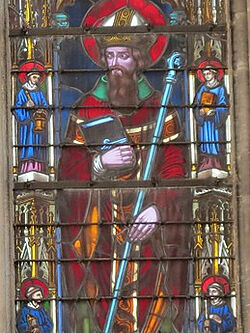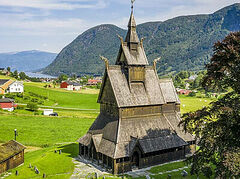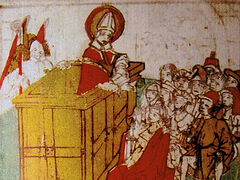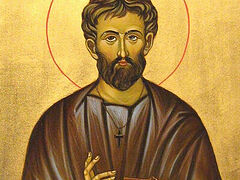St. Exupère of Bayeux (†c.405)
St. Loup of Bayeux (†c.470)
St. Laud of Coutances (†c.565)
St. Romanus of Rouen (†c.640)
St. Ouen of Rouen (†684)
St. Hugh of Rouen (†730)
St. Sulpice of Bayeux (†844)
From early on and up nearly to the very end of its Orthodox history, the region of northwestern France now known as Normandy was graced with a veritable pleiad of holy hierarchs. Indeed, the grouping presented here represents only a small cross section of the holy bishops who shone forth in the various great cities of that area. Examples of similarly illustrious men could easily be cited in addition to these, swelling this section to book length by itself! Here are a few especially notable sainted hierarchs of this region.
The holy St. Exupère (alternately spelled Exuperius, Spirius, Spire, Soupir, Dispar, Ispar, or Soupierre) is, by tradition, the first bishop of the see of Bayeux. This city near the coast of the English Channel has long been among the most important in the Normandy region. St. Exupère founded the diocese, making him the inaugurator of ecclesiastical life in that city.
Details about the life of St. Exupère are scarce. Further, there is some discrepancy in the sources about the exact chronology of his life. However, we have some information concerning his activities and miracles. He may have been originally from Rome, being sent to northern Gaul as part of a papal mission to evangelize the area of the Bessin. He is said to have contended against idolaters whose activities were apparently based in the forests near Mt. Phaunus west of Bayeux. Through his preaching and miracles, he was able to convert many to Christ. One account tells of him exorcising seven demoniacs by his prayers. Thus did he labor mightily, working great wonders, to enlighten the area.
 St. Exupere performs an exorcism
St. Exupere performs an exorcism
Like many saints of this region, St. Exupère’s relics had to be relocated due to Viking invasions in the 9th century. The bulk of them ended up in Corbeil, a suburb of Paris. Though it is now unclear, a portion of his relics may have also been taken to England in the 12th century. Among the many saints that followed him in the cathedra seat of Bayeux are: St. Loup (see below), St. Vigor (†c.537), St. Regnobert (†c.660), and St. Sulpice (see below).
 St. Loup of Bayeux. Tympanum of the bell tower of the St. Loup church in Saint-Loup-Hors Calvados.
St. Loup of Bayeux. Tympanum of the bell tower of the St. Loup church in Saint-Loup-Hors Calvados.
St. Loup (Lupus), another of the many holy bishops of Bayeux, was a native of that city. Born into a pagan family, he was enlightened with the faith of Christ, by St. Rufinianus (†c.434), who also later ordained him to the diaconate and whose successor he would eventually be. St. Loup was the most brilliant of the pupils of St. Rufinianus. He was consecrated to the episcopate as St. Rufianus’ successor by Sylvester, archbishop of Rouen. Owing to his great knowledge and personal holiness, he was elevated to that station by popular acclaim and crowned by the archbishop.
Few details have been preserved of St. Loup’s life and deeds during the period of his episcopate of Bayeux. It is related that he miraculously restored sight to two blind people. Another story relates how the saint—whose name, Loup or Lupus, means “wolf”—vanquished a fierce wolf that had caused havoc in a local commune, casting it into the Drôme River.
Like St. Exupère, his relics were originally kept in Bayeux before being relocated to Corbeil in the 9th century due to Norman raids. Tragically, his relics were destroyed during the Revolution. A commune in the Calvados area of Normandy bears his name.
St. Laud (or Lô) of Coutances was born in Courcy in the coastal Manche area (the same area that includes the famous Mont Saint-Michel). He served as the fifth bishop of the nearby city of Coutances. An ancient city, Coutances was named for Constantius Chlorus, father of the first Christian emperor St. Constantine the Great (†337), who once ruled the Western part of the Roman Empire. The diocese of Coutances dates to the 5th century. However, some sources place his birth in the city of Briovère or even Britain.
 St. Laud of Coutances St. Laud assumed the bishopric of Coutances around the year 525. He succeeded another saint, Possessor. A remarkable and precocious man, he rose to this position before attaining the age of thirty!
St. Laud of Coutances St. Laud assumed the bishopric of Coutances around the year 525. He succeeded another saint, Possessor. A remarkable and precocious man, he rose to this position before attaining the age of thirty!
St. Laud participated in a conclave in Angers and Councils in Orléans in 541 and 549. A great organizer, he set up dioceses, founded churches, and also selflessly donated his own lands for church use. Upon his repose he was immediately proclaimed a saint and his veneration was quite strong. He is considered a patron saint of Coutances and was especially venerated in Briovère, where he had lived for many years and where his relics were interred. The city now bears the name Saint-Lô in his honor. Many other communes and churches in that area similarly bear variants of his name, a testimony to the enduring love for this sainted hierarch.
St. Laud is particularly invoked for eye-related maladies. A miraculous spring with healing properties at Courcy, his likely birthplace, is also associated with his name. His holy relics, divided between Angers, Bayeux, and Rouen, escaped the ravages of the Revolution and world wars, and are preserved to this day.
 An image from the life of St. Romanus
An image from the life of St. Romanus
St. Romanus (Romain) of Rouen is the first of three sainted hierarchs of the city of Rouen to be discussed in this section. Rouen, in times past, was one of the greatest and most prominent cities in all of Europe. St. Romanus, a man of remarkable learning and ability—as well as great holiness—was fully equal to the challenge of the bishopric of so great a city.
Born into the aristocracy, his birth itself was accompanied by miracles. An angel appeared to his father, Benoît, foretelling the birth of a son despite his mother Félicité’s sterility. He was raised at the royal court of king Childéric I, where he was brilliantly educated. He made the acquaintance of St. Eligius (Éloi) of Noyon (†660) and St. Ouen (see below). St. Romanus served at court, possibly under Clotaire II, as both chancellor and referendary (essentially an official in charge of royal correspondence).
Numerous miracles are associated with his life, including miraculous destructions of pagan temples, banishment of demons (including of one who appeared to him in the form of a woman and attempted to seduce him into sin), and lowering the level of a river that was about to overflow its banks. He was observed levitating while celebrating Mass. A miraculous holy spring is also associated with the saint.
Near his holy spring St. Romanus had a hospital built for the poor. There was a longstanding tradition in Rouen for many centuries of pardoning a condemned criminal each year, which was indicated by handing the pardoned individual the relics of St. Romanus. This tradition, known as the “Privilege of St Romain,” was observed each year on Ascension. It lasted from the mid-12th to the late 18th centuries.
On his repose, St. Romanus was interred in a marble sarcophagus in Rouen and soon came to be regarded as a heavenly protector of the city. There seem to be conflicting traditions as to whether or not his head was kept at Soissons for a time. His feast is observed October 23.
The successor to St. Romanus as bishop of Rouen, St. Ouen (alternately Audoin or its anglicized form, Owen) was one of the truly great ecclesiastical figures and holy men of his age. He was reared in an atmosphere of holiness in the Abbey of Saint-Médard in Soissons (which was named for and housed the relics of St. Medard of Noyon), one of the most important monastic establishments of that age. Like his predecessor, he also served in the Frankish royal court where he, too, held the notable position of referendary.
St. Ouen was the scion of a wealthy and landed aristocratic family. He was from early on always in the company of saints: His first cousin was the holy hierarch St. Agilbert (†c.670–680), bishop of the West Saxons in England and later bishop of Paris. During his time at court he became friends with St. Wandregesilius (see below) and St. Didier (†755), later bishop of Cahors in southern France, as well as St. Eligius (Éloi) of Noyon (mentioned above).
St. Ouen was a missionary and miracle worker, and was also active in the founding of monasteries. Perhaps the most important of these monasteries was the famous Abbey of Fontenelle, one of Normandy’s great centers of learning and holiness for centuries and a veritable factory of saints for generations. Specifically, Fontenelle Abbey was founded by his friend, the great ascetic and monastic figure St. Wandregesilius, on lands acquired through St. Ouen’s royal influence.
Upon ascending the cathedra seat of Rouen following the blessed repose of St. Romanus, St. Ouen set about further distinguishing himself as one of the outstanding churchmen of any time and place. In addition to helping in the founding of monasteries, he was also a significant monastic reformer and teacher, combining elements of Benedictine and Columbanian monastic rules (both of which, as will be discussed later on, were centrally influential in the monastic life of northern and western Europe at that time). He was also a collector of holy relics, with which he generously adorned the many churches and monasteries in his see.
Bishop Ouen remained as ever prominent in Neustrian court life and was a close advisor to the holy Queen St. Bathilde (†680). His influence once even helped broker peace between warring kingdoms.
Upon his holy repose, in peace in the year 684, he was interred in the abbey church of Saint Peter, originally founded, it is believed, by St. Clotilde (†545), Queen of the Franks, through whom the whole French nation was, in effect, baptized. Before long, this monastery, whose fame only grew for housing the holy hierarch’s much venerated remains, was rededicated in his honor, becoming known thenceforth as the Abbey of Saint-Ouen. As a sign of the immense esteem in which the holy one was held, his relics were interred directly behind the high altar at the initiative of his holy successor, St. Ansbert of Chaussy (†695).
 St. Hugh in stained glass in Notre-Dame de Bonsecours St. Hugh (Hugues), archbishop of Rouen, followed a few decades after St. Ouen and similarly upheld a lofty standard of utmost holiness during his episcopate. Like so many of the great bishop saints of that time and place, he was of high birth. His father, Drogo, was a duke. He was a nephew of the celebrated Charles Martel. Holiness also characterized the family lineage, even well before St. Hugh’s time: His great-great-grandfather was the holy hierarch St. Arnulf (Arnold) of Metz (†c.645).
St. Hugh in stained glass in Notre-Dame de Bonsecours St. Hugh (Hugues), archbishop of Rouen, followed a few decades after St. Ouen and similarly upheld a lofty standard of utmost holiness during his episcopate. Like so many of the great bishop saints of that time and place, he was of high birth. His father, Drogo, was a duke. He was a nephew of the celebrated Charles Martel. Holiness also characterized the family lineage, even well before St. Hugh’s time: His great-great-grandfather was the holy hierarch St. Arnulf (Arnold) of Metz (†c.645).
St. Hugh was deeply involved in and closely connected to both of the great monastic centers of Neustria: Jumièges and Fontenelle Abbeys. He entered the former as a monk in his youth, receiving thereby a priceless spiritual formation in an atmosphere of exemplary holiness. Later, he served as abbot of Fontenelle for about a four-year period, 719–723, serving between Saints Wandon (†c.756) and Landon. He then served a stint as abbot of his former monastery, Jumièges.
St. Hugh was apparently a man of almost indefatigable energy. He was elevated to the archbishopric of Rouen, which itself would have been work enough for a lifetime. However, seeing a need for his services, he additionally took charge of the dioceses of Bayeux and distant Paris! His administrative abilities—like his prayer and virtue—must have been immense.
St. Hugh eventually retired from his great duties, wearied, perhaps, from the heavy labors he shouldered for so long, passing his final days prayerfully in his former monastic home of Jumièges. Showing his great humility, the former archbishop lived there as a simple choir monk. There he reposed in peace in the year 730. Like many of the saints of that region who lived prior to the 9th century, his relics had to be relocated to protect them from Viking raids; they were brought eastward to the area of present day Belgium.
 St. Sulpice of Bayeux The final great hierarch to be discussed here, though far from the last to adorn that region, is St. Sulpice of Bayeux. Despite being later in time than the others mentioned here, however, not much is now known with certainty about him.
St. Sulpice of Bayeux The final great hierarch to be discussed here, though far from the last to adorn that region, is St. Sulpice of Bayeux. Despite being later in time than the others mentioned here, however, not much is now known with certainty about him.
The salient fact about St. Sulpice’s life is that he was a hieromartyr: While many of the saints of the region and of northwestern France generally had their holy relics evacuated from the area during the 9th century—the time of the great Viking Norman invasions—St. Sulpice’s lot was to live in this time and suffer through it, eventually accepting a martyr’s crown.
St. Sulpice was apparently a native of Livry, in what is now the Calvados portion of Normandy. There was a monastery there which had been founded in the 7th century by St. Gerbold (†690), a former bishop of Bayeux. It is possible that St. Sulpice spent time as a monk there. At any rate, he was apparently fond of retreating there for periods of prayerful solitude.
It appears that St. Sulpice’s episcopacy of Bayeux was quite brief. He was apparently elevated to that dignity around the year 840. And his martyric repose happened in 843. The exact circumstances of his holy death, and even its exact location (probably either Bayeux or Livry), has been lost in the mists of time. What is known is that the (then still aggressively pagan) Vikings executed him. His situation is thus in a real sense emblematic of the situation of Christians in northern France and other coastal areas of Northern Europe generally in that era, exposed as they were to constant danger. Their faith and perseverance, their deep trust in God in the face of nigh constant danger as exemplified by this brave holy hierarch, is an inspiration to us today.
The relics of St. Sulpice were taken from Bayeux to the Abbey of Saint-Ghislain in Hainaut, Wallonia in present-day Belgium. (This abbey had been founded by the holy ancho rite St. Ghislain of Mons, †680, in the mid-7th century). However, centuries later they were belatedly returned to Normandy, where they were placed in the Abbey of Saint-Vigor-le-Grande, founded by and later named for a previous sainted bishop of Bayeux, St. Vigor (†c.537). A chapel in Livry purportedly marked the spot of St. Sulpice’s martyrdom. Multiple healing springs are associated with the saint, and a commune in Normandy is named for him, testifying to his enduring veneration.
Thus, through the lives of these seven holy hierarchs of Orthodox Normandy, we see a brilliant cross section of the grand tradition of sanctified episcopal leadership that guided and enriched that area of France for multiple centuries. May we benefit from their exalted examples, and have the blessing of their prayers!
To be continued…






